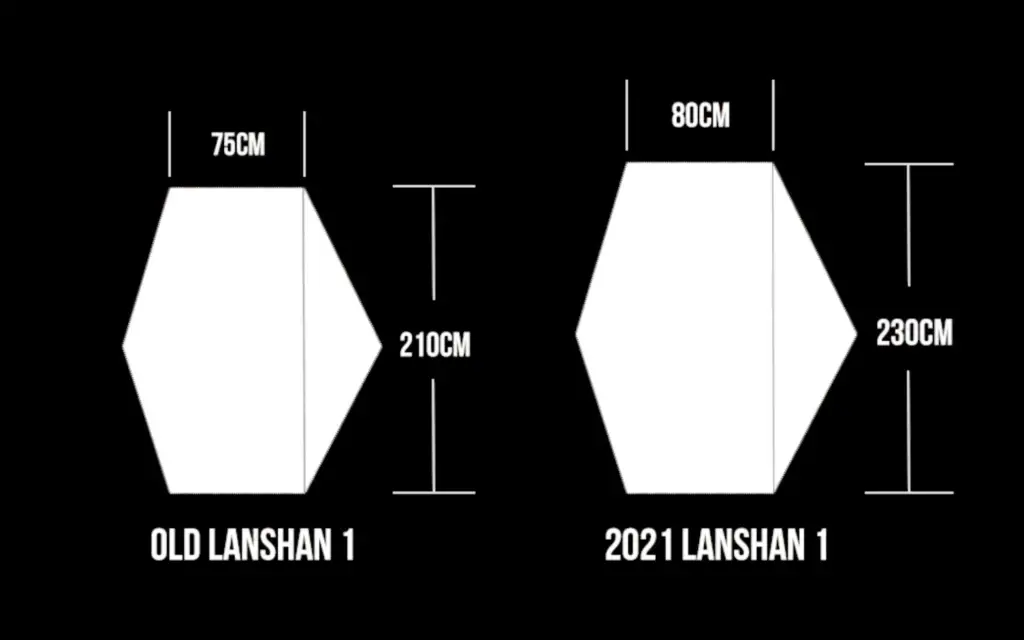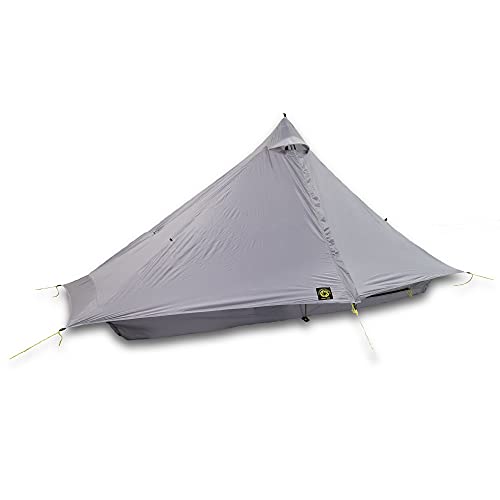The Lanshan 1 and the Lunar Solo are both lightweight backpacking tents designed for one person. While they have some similarities, they also have some differences that may be important to consider when choosing between them.
Here are some key differences between the Lanshan 1 and the Lunar Solo:
- Design: The Lanshan 1 is a double-wall tent, which means it has both an inner and outer layer. The Lunar Solo, on the other hand, is a single-wall tent, which means it has only one layer of fabric.
The advantage of a double-wall tent is that it provides better ventilation and condensation control. The advantage of a single-wall tent is that it is typically lighter and easier to set up. - Weight: The Lanshan 1 weighs around 24.4 oz or 690 g, while the Lunar Solo weighs around 26 oz (740 g). This makes the Lanshan 1 slightly lighter than the Lunar Solo.
- Floor space: The Lanshan 1 has a floor space of around 20.5 square feet (1.9 square meters), while the Lunar Solo has a floor space of around 26 square feet (2.4 square meters). This makes the Lunar Solo slightly more spacious than the Lanshan 1.
- Price: The Lanshan 1 is typically less expensive than the Lunar Solo, which may be a factor for those on a budget.
In general, the Lanshan 1 may be a better option for those who prioritize weight, price and ease of set up, while the Lunar Solo may be a better option for those who prioritize space and ventilation.
However, both tents are excellent options for backpackers and hikers who want a lightweight and durable shelter for their adventures.
Design and features
One of the things I really like about the Lunar Solo is the fact that the doors can be pinned back, allowing for a nice breeze through the tent on warm nights.

The Flames Creed 1 also has this feature, but it doesn’t have a gap underneath the hood, which means it may not be as good at preventing condensation buildup.
In terms of build quality, both tents feel secure and well-made. The Lunar Solo has two strengthening stitches to join the guy-line, while the Flames Creed 1 only has one.
However, as long as you don’t get abrasions on rocks, this shouldn’t be an issue for either tent.
Materials and price
The Lunar Solo has a 20 Denier silicone treated 190T polyester flysheet, whereas the Flames Creed 1 has a 15 Denier nylon flysheet.
Nylon is typically lighter and stronger than polyester, but also tends to sack more (absorbs water) when it rains, and it is more expensive to produce.
This means that the Lunar Solo is a bit more expensive, at around $230, while the Flames Creed 1 costs around $100.
However, the shape-fast polyester makes it possible for the Lunar Solo to be a single-walled tent with an integrated bug net, while the Flames Creed 1 has a separate bug net that needs to be set up.
The Lunar Solo is also more spacious for a one-man tent, with plenty of room for gear and storage. BUT the Lanshan has a 2021 updated version with a slightly bigger floor area (read on!).
The Lanshan Flames Creed 1 tent is slightly different from the Lunar Solo in that it has a removable bathtub floor, whereas the Lunar Solo has a sewn-in bathtub floor.

This means that you can patch the outer or inner separately or remove it entirely, which some people may find more convenient for storage.
However, the Flames Creed 1 is not as spacious as the Lunar Solo and has less headroom, with my head touching the sheet when I’m lying down.
Waterproof ratings of Lanshan 1 and Lunar Solo
In terms of waterproofing, the Lunar Solo has a 3,000 millimeter hydrostatic head, while the Flames Creed 1 is states a 5,000 millimeters hydrostatic head.
The groundsheet of the Flames Creed 1 is even better, at 8,000 millimeters hydrostatic head.
If you’re camping in a lot of wet weather, the Lunar Solo may not be as waterproof as the Flames Creed 1.
However, I haven’t experienced any issues with the Lunar Solo, even in heavy rain, and in theory, the polyester flysheet is thicker and more water resistant, so it could just be differences in how the two manufactures measure (or report!) it.
The 2021 updated Lanshan 1 tent
he Lanshan 1 is a popular ultralight tent among backpackers and hikers due to its lightweight and easy-to-pitch design.
However, one of the most common criticisms of the tent has been its limited space, particularly for taller individuals.
In response to this feedback, a new version of the Lanshan 1 was released in 2021 with an enlarged inner length of 230cm, up from the previous 210cm.

This increase in length provides additional space for taller individuals to sleep more comfortably without feeling cramped or confined.
The extra space also allows for more storage room for gear and provides better ventilation, helping to prevent condensation buildup.
Despite the larger size, the tent remains lightweight and compact, making it an excellent choice for backpackers and hikers who prioritize weight and packability.
Lanshan 1 vs. Lanshan 1 Pro?
The Lanshan Pro is meant as an upgrade to the original Lanshan 1 tent and it is lighter, bigger and more durable.
The main differences between the Lanshan 1 and the Lanshan 1 Pro tents are:
- Size: The Pro version of the Lanshan 1 is a fair deal larger than the standard version (see photo below).
- Weight: The Lanshan 1 Pro is lighter at 690g compared to the original Lanshan 1 (780g), with a weight difference of around 100g, depending on the specific configuration.
- Material: The Lanshan 1 Pro is made with silnylon, meaning that it is silicon impregnated rather than just surface treated (less sacking). It is also 20D nylon whereas the Lanshan 1 is 15D. The Pro version also has reenforced attachment points for the guy lines.
- Inner tent: The original Lanshan 1 has a removable net inner tent, while the Lanshan 1 Pro is a single wall tent with netting sewn directly from floor to fly walls, which is not removable. This causes more condensation in the Lanshan Pro compared to the Lanshan 1 tent.
It’s worth noting that although the original Lanshan often comes seem sealed, both tents may still need to be seam-sealed further to be fully waterproof.
Both tents also feature vestibule doors that can be rolled back for airflow and views.
Overall, the Lanshan 1 Pro may be a better option for those who prioritize a lighter, yet durable tent and prefer a single wall tent with netting sewn directly into the walls, while the Lanshan 1 may be a better option for those who prefer a removable inner tent and are not as concerned about weight.
Good alternatives to Lanshan 1 and Lunar Solo
If you are not yet convinced that the Lanshan 1 or the Lunar Solo is for you, there are other options out there.
Take a look at my full rundown of 20+ ultralight 1 and 2 person tents from high quality budget brands in my recent post on the best ultralight cheap tents here.
The KIKILIVE Tent comes in a cool red color and is very affordable! It weighs a bit more than the Lanshan and Lunar tents at 1kg, but the materials are the same…
Some other tents have a similar design, but less branding (No-name) and lower price, but all are somewhat heavier than the Lanshan 1 and Lunar Solo tents.
The so called MIER tents are just Lanshan in disguise – they are the same!
Naturehike has a nice 1 person tent is free-standing and very affordable, but somewhat heavier than the Lanshan and Lunar Solo tents.
| Image | Product | Features | Price |
|---|---|---|---|
 | Very similar to Lanshan 1 but cheaper! | Check Price | |
 | MUCH cheaper Lanshan 1 clone. | Check Price | |
 | An ultralight Classic, but you pay the price! | Check Price | |
 | Large freestanding tent. | Check Price |
These are just some of my favorite budget ultralight tents I have tested. If you need a bigger tent I can warmly recommend the Naturehike Mongar Tent (my review) that is super spacious an functional for the price!
Conclusion
Overall, both the Lunar Solo and the Flames Creed 1 are great tents for backpacking or camping.
If you’re looking for a more spacious tent with a sturdier rain fly, the Lunar Solo may be a better choice, but if you want a much more affordable option that’s still waterproof and well-made, the Flames Creed 1 is definitely worth considering instead.
If you are after larger tents or even cheaper options, check out my budget ultralight tent overview here.









